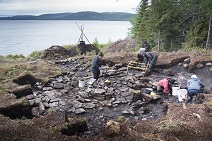Community Archaeology
July 2016
In Rigolet, Nunatsiavut, Labrador, archaeology is a community affair. The residents of this Inuit hamlet of about 300 people take great pride in their community, and interest in their local history. The community’s tourism strategy is hoping that others will share their fascination as well.
“The way things have shaped out is that we have become part of that tourism process and that was really fun,” says Memorial University archeologist, Lisa Rankin, who is excavating three Inuit sod houses near Rigolet. “We had lots of tourists and local people coming out to the site, it’s a nice walk or little boat ride away.”
Rankin is excavating three traditional dwellings which were once a seasonal winter settlement, dating back over 200 years. In the fall of 2015 Rigolet completed a wooden boardwalk, the longest in North America, stretching over 8 kilometres from the community to the excavation site at Double Mer Point.
The community thought that having a reconstructed sod house at the end of the boardwalk would give visitors a destination. However, little did they know, the excavation itself would become an attraction.
“Each year we’re getting more and more people to come walk the boardwalk and see the archeological site,” says community member Inez Shiwak. “People are coming from other communities and taking weekend trips from Goose Bay on the boat. We’ve had people come in from other communities on long liner because they heard of the boardwalk and want to check out the site.”
The sod houses were built at a traditional winter hunting spot, where the ice remains open all year, making it much easier to catch marine mammals like seal. Rankin says that it looks like people have been coming to this area for quite some time, and there are a number of tent rings in the area that may or may not be related to the site.
For Shiwak each day of excavation is an adventure, and she says the whole community is keenly interested in what the archeologists and their team discover.
“It’s exciting discovering who was here and what they were doing, and how many families were there,” exclaims Shiwak, “especially now with boardwalk joining up with it. It’s an attraction we never thought we’d have here, we never thought people would have access to it.”
The Nunatsiavut Research Advisory Committee reviews all archaeological work being done in the region. If construction is to happen at an archaeological site, first there must be an excavation. The archaeology team has a discovered a wide range of artefacts, many of them traditional Inuit pieces made from bone or stone. These items are harder to date as people made the same style of tools for hundreds of years.
The families living in these houses definitely had contact with Europeans as Rankin and her team have found many European items, ranging from iron nails hammered into spear tips to a Ottoman smoking pipe from Turkey (most likely traded by sailors). The European goods have helped the team date the sod houses to the late 1700 hundreds, possibly early 1800s, she is unsure whether all three sod houses were inhabited at the same time, or if only one house stood at a time.
The archeological team set up a laboratory in the Net Loft Museum, located in the centre of town. Here they cleaned, prepared, and catalogued their finds. Interested community members, would stream in and out of the building each day, chatting with the archeologists, and helping them to identify artefacts.
“We would become dependent on those community members because a lot of the artefacts were things my group hadn’t seen before,” explains Rankin. “Or they were European artefacts and we knew what they were, but they were modified for Inuit use, and we couldn’t figure out what the use was. So the local community members really helped us identify the full range of artefacts.”
For the community of Rigolet, the project has not only helped them to develop a tourism strategy but it is giving them a window on their direct past.
“It’s a part of our history and it shows us what life was like back in the day,” says Shiwak, “and now we’re able to share that with others, and by letting other people know what was happening in this area before, we get even more connected to the land, and shows them and reminds us that the land is important [to Inuit].”
Lisa Rankin and the archeological team plan on returning to Double Mer Point to work with Rigolet once again this summer. This is their last scheduled summer working at the site. While the conclusion of this project is bitter-sweet, its impact on the local tourism industry will be felt for years to come.





